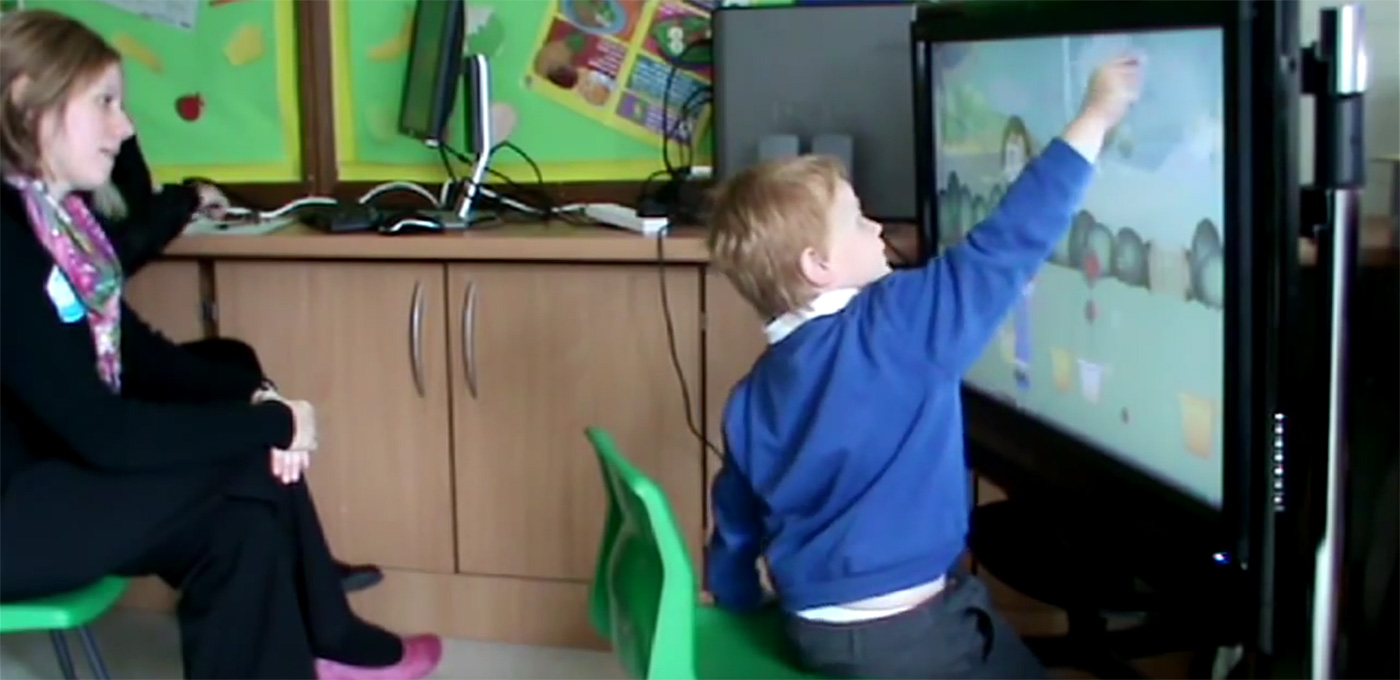ECHOES Project
Supporting autistic children in learning of social interaction skills through intelligent technology

9 January 2018
By Kaska Porayska-Pomsta.
ECHOES is a technology-enhanced learning (TEL) environment for 5 to 7 years old children where they can explore and practise skills needed for successful social interaction, such as sharing of attention with others, turn-taking, initiating and responding to bids for interaction. ECHOES supports typically developing children (TD) and children with autism spectrum disorders (ASCs). As well as being a tool for learning by children, ECHOES is a research tool for exploring the specific difficulties of individual children in relation to social interaction.
The project employed participatory design methodology to allow the researchers to co-design the environment with children and teachers and to determine how it could be used in real classrooms. ECHOES also relied on clinical and educational intervention framework (called SCERTS) and utilised Artificial Intelligence techniques in order to record and interpret interaction data between children and the environment. This data coupled with the data obtained through the ECHOES' evaluation provides the basis for the project's findings and motivates further research.
“As well as being a tool for learning by children, ECHOES is a research tool for exploring the specific difficulties of individual children in relation to social interaction.
As well as being a tool for learning by children, ECHOES is a research tool for exploring the specific difficulties of individual children in relation to social interaction.
ECHOES was evaluated in 4 UK schools, over eight weeks. Quantitative analysis of social communication behaviours using a specially designed coding scheme revealed positive improvement trends in responses to human partner initiations whilst using ECHOES. The improvement observed during ECHOES indicates the potential for TEL environments such as ECHOES to facilitate previously unobserved social communication skills in children with ASC and points the way to further modifications required at the technology engineering level to engender flexibility and extendability of TEL that fits diverse contexts of use.
Looking at the development of social skills in Asperger's Spectrum and typically developing 5-7 year olds using multi-touch screens, AI and gaze and motion capture technology among other technologies in a multimodal environment.
The main findings of the project relate to:
- Efficacy and usefulness of technology enhanced environments in supporting social communication skills by children with ASC. Quantitative analysis of social communication behaviours using a specially designed coding scheme revealed improvement trends in responses to human partner initiations whilst using ECHOES. The improvement observed during ECHOES indicates the potential for TEL environments such as ECHOES to facilitate previously unobserved social communication skills in children with ASC (Bernardini, Porayska-Pomsta, Smith and Avramides, 2012; Bernardini, Porayska-Pomsta and Smith, 2013). Some children also showed an improved ability to self-regulate emotionally, especially in the context of the ECHOES task-based activities (Alcorn et al., 2011), to turn-take and share attention with others (Menzies, 2012). Observing such behaviours allowed teachers to appreciate the child's hidden potential and to tailor the support accordingly, thus having instantaneous impact on the specific intervention and practice for the particular children. Observing the individual children to behave more spontaneously and communicatively in the context of ECHOES than in the classroom was reported by the teachers as the key aspect of the ECHOES environment and the reason for their enthusiasm to see technologies such as ECHOES in their classrooms.
- Importance of technology-enhanced approaches, especially those that utilise Artificial Intelligence methods (user modelling and autonomous agents) both to support learning and research about learning. From the outset, ECHOES was set up to log and interpret the interaction data in real-time. The logging of data is used to capture low-level information (e.g. where the child is touching the screen at any given point; how long does the child takes to respond) and this log data is used to infer patterns of behaviour for each child, to (a) inform the system's design, especially the ability of the virtual character to interact with the child in real-time and (b) inform about each child's progress in minute detail, not feasible in normal classroom circumstances. In attempting to be adaptive based on real-time capture and interpretation of data, coupled with encouraging results and enthusiastic response by teachers, ECHOES provides an early and important step towards adaptive technologies for autism. The logged data also provides a precious resource for the generation of further hypotheses related to the individual children and children with ASC more generally, of relevance to psychologists, education experts and computer scientists (Bernardini, Porayska-Pomsta and Smith, 2013).
- Participatory design (PD) methods involving young children with ASD and their carers in the design of the technologies for use by them. ECHOES invested in PD from the start and has successfully extended and tested the existing methods of involving young children with autism and their teachers in the design of technologies for use by them (Frauenberger, Good, and Keay-Bright, 2011), thereby contributing further to human-computer interaction research.
Impact
ECHOES prioritises communicative skills such as joint attention and turn-taking and it also serves as a tool for researchers, teachers, parents, and practitioners to hep them understand better individual children’s strengths and difficulties, and the ways in which these may be addressed through technology-enhanced support.
 Close
Close

